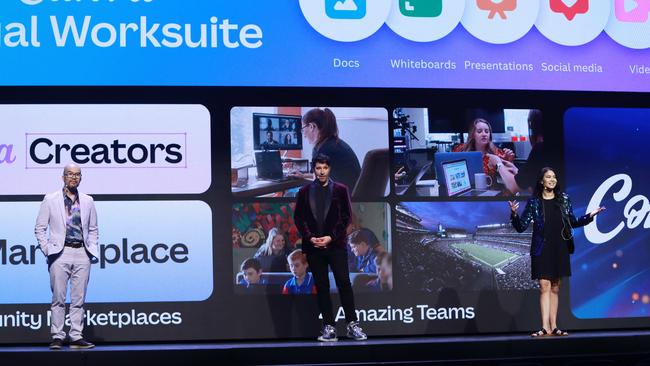Canva plots assault against Adobe as lucrative enterprise market heats up
After making some staff millionaires, Canva is now planning to undercut a Silicon Valley titan to woo more corporate customers ahead of a much-hyped public listing.

Business
Don't miss out on the headlines from Business. Followed categories will be added to My News.
Canva is plotting an assault against Adobe, looking to undercut the US tech behemoth, as it intensifies its efforts to seize a greater share of the enterprise market ahead of a potential public listing.
Servicing the graphic design needs of companies is where Canva – now valued at $US32bn following several secondary share sales last year, making some staff instant millionaires – sees its next big revenue opportunity.
Its annualised revenue vaulted 13.6 per cent to $2.5bn last year after it topped more than 225 million monthly users – about 22 million of them paying subscribers. Companies say they are already saving money, with Australian real estate group Raine & Horne saying it no longer needs spend about $20,000 a month on a graphic design agency.

Chief customer officer Rob Giglio — formerly an executive at Adobe, DocuSign and HubSpot — said Canva was now looking to turbocharge one its latest acquisitions, British Photoshop rival Affinity, to gain a bigger slice of the enterprise market.
“Canva acquired Affinity about a year ago. And we’ve been working aggressively on how do we continue to improve Affinity to the point where Affinity could be a tool that is way less expensive than the Adobe suite of products,” Mr Giglio said.
“Adobe could sit nicely in that workflow and we’re going to have exciting news for you soon to talk about how Affinity will come to life. I’m not tipping anything necessarily but as you can imagine, we wouldn’t buy them just to sit on it.
“We see the opportunity for bespoke asset creation to scale imagery at a way lower cost of tooling.”
It’s been five years since Mr Giglio left Adobe, where he served as senior vice-president of worldwide go-to-market and sales, leading a team of more than 650 people.
“I was super-aware of Canva when I was at Adobe. I was impressed. It’s a tool that is so easy to use, the users love it.
“I had to be gone five years before I could actually get my head around working for a competitor.”
Canva redesigned its entire platform to attract more paying subscribers from the world’s biggest companies. It launched a suite of new products in Adobe’s backyard at its annual Create showcase in Los Angeles – the first time it has moved the event from Australia.
The new offerings included Canva Courses, to allow companies to make their own training modules; Canva Enterprise, a product that builds on its Pro and Teams versions; Canva Work Kits, a set of tools and templates for different teams within an organisation; and significant upgrades to its Visual Suite and Magic Studio.
It comes ahead of a potential Nasdaq listing, which co-founder and chief product officer Cameron Adams said would be a “natural evolution” for the company.

Mr Giglio, who has been at the company for about a year, has been selling Canva’s vision and products to companies around the world. He said 95 per cent of Fortune 500 companies were now using Canva “at scale”.
“I would say the feedback sounds something like, ‘Where have you been?’,” Mr Giglio said.
“What we’re finding is that large businesses … already knew that they were using Canva. People would talk about it. People would use it in decks. They would create printed material using Canva. And yet there was no Canva person that was in the party. It was like just kind of coming from the bottom up.
“And so then when we showed up our sales team and our customer success team, and we started sending emails to them, talking to them like they were a business user, it was ‘well, we’re glad you finally showed up, Canva, because we we’ve been using this for a while, and we could actually use some feedback on this, or we could use some training on that, and we’d actually like to have more seats’.”
But the biggest concern, as with any BYO software employees use, was security compliance.
“It allows the teams to do work in a more organised way,” Mr Giglio said.
“And the reason I say organised is having single sign-on allows them to keep track of people who are using the product and who have access to it. So you sort of get some containment.”
This did not mean stifling creativity, Mr Giglio said; rather it allowed for a more consistent brand style.
“You think franchises, you think multiple location businesses, you think sales teams, anything where there is a large volume of people who are in the activation mode of assets that come from a headquarters are the perfect prospect for Canva, because we allow exactly that – a certain amount of control and design expertise at a headquarter level, and then scale at the individual user level. That’s resonating with the market.”
Raine & Horne head of marketing Michael Carroll – who also uses Adobe’s generative artificial intelligence tool Firefly – said Canva allowed the firm to significantly increase its creative output.
“In 2023 we had about 66,000 unique designs published. In 2024 we had over 77,000 designs published. Eighty per cent of our network are using the platform.
“We’ve starting talking about integrating it with our CMS (content management system) to make things easier: two clicks and all our templates are populated.
“Five years ago, we were paying an agency a $20,000 retainer a month to give us assets that would probably take us two hours to design. The cost effectiveness of the tool is phenomenal and obviously it’s still evolving.”
Originally published as Canva plots assault against Adobe as lucrative enterprise market heats up



